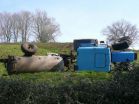(Press-News.org) Conservation paleobiologists--scientists who use the fossil record to understand the evolutionary and ecological responses of present-day species to changes in their environment--are putting the dead to work.
A new review of the research in this emerging field provides examples of how the fossil record can help assess environmental impacts, predict which species will be most vulnerable to environmental changes, and provide guidelines for restoration.
The literature review by conservation paleobiologists Gregory Dietl of the Paleontological Research Institution and Cornell University and Karl Flessa of the University of Arizona is published in the January, 2011, issue of the journal Trends in Ecology and Evolution.
The National Science Foundation (NSF) funded the research.
"Conservation paleobiologists apply the data and tools of paleontology to today's problems in biodiversity conservation," says Dietl.
The primary sources of data are "geohistorical": the fossils, geochemistry and sediments of the geologic record.
"A conservation paleobiology perspective has the unique advantage of being able to identify phenomena beyond time scales of direct observation," Dietl says.
Such data, says Flessa, "are crucial for documenting the species we have already lost--such as the extinct birds of the Hawaiian islands--and for developing more effective conservation policies in the face of an uncertain future."
Geohistorical records, the authors write, are critical to identifying where--and how--species survived long-ago periods of climate change.
"Historically, paleontologists have focused their efforts on understanding the deep-time geological record of ancient life on Earth, but these authors turn that focus 180 degrees," says H. Richard Lane, program director in NSF's Division of Earth Sciences, which funds Dietl's and Flessa's research.
"In putting the dead to work, they identify the significant impact knowledge of fossil life can have on interpreting modern biodiversity and ecological trends."
Ancient DNA, for example, has been used to show that the arctic fox (Alopex lagopus) was not able to move with shifting climates as its range contracted, eventually becoming extinct in Europe at the end of the Pleistocene.
However, the species persisted in regions of northeastern Siberia where the climate was still suitable for arctic foxes.
In another tale from the beyond, fossil evidence suggests that the birds of the Hawaiian Islands suffered large-scale extinctions around the time of the arrival of the Polynesians.
Studies comparing the ecological characteristics of bird species before and after these extinctions reveal a strong bias against larger-bodied and flightless, ground-nesting species.
The pattern suggests that hunting by humans played a role in the extinction of the flightless species.
By the 18th century, the time of the first Europeans' arrival in the islands, most large-bodied birds had already disappeared. European colonization of the islands led to a second wave of exctinctions.
Those birds that survived had traits that helped them weather two onslaughts.
In their review paper, Dietl and Flessa cite a study of the frequency in the fossil record of insect damage to flowering plant leaves in the Bighorn Basin of Wyoming dating from before, during and after the Paleocene-Eocene Thermal Maximum (PETM, some 55.8 million years ago).
The PETM, scientists believe, is one of the best deep-time analogs for current global climate change questions.
Results from the insect research suggest that herbivory intensified during the PETM global warming episode.
"This finding provides insights into how the human-induced rise in atmospheric carbon dioxide is likely to affect insect-plant interactions in the long run," the authors write, "which is difficult to predict from short-term studies that have highly species-specific responses."
The dead can help us even in remote places like the Galapagos Islands.
Scientists have used the fossil pollen and plant record there to show that at least six non-native or "doubtfully native" species were present before the arrival of humans.
This baseline information, says Dietl, "is crucial to a current conservation priority in the Galapagos: the removal of invasive species."
An important role of geohistorical data is to provide access to a wider range of past environmental conditions--alternative worlds of every imaginable circumstance.
Tales of the past that may lead to better conservation practices, crucial for life, not death, on Earth.
The dead, it turns out, do tell tales.
INFORMATION:
Putting the dead to work
Conservation paleobiologists dig deep to solve today's ecological, evolutionary questions
2011-01-15
ELSE PRESS RELEASES FROM THIS DATE:
Stanford researcher uses living cells to create 'biotic' video games
2011-01-15
VIDEO:
Stanford physicist Ingmar Riedel-Kruse has begun developing "biotic games " involving paramecia and other living organisms. He hopes the games lead to advances in education and crowd-sourcing of laboratory research while...
Click here for more information.
Video game designers are always striving to make games more lifelike, but they'll have a hard time topping what Stanford researcher Ingmar Riedel-Kruse is up to. He's introducing life itself into games.
Riedel-Kruse ...
Study provides molecular rationale for combining targeted agents to treat breast cancer
2011-01-15
COLUMBUS, Ohio – A new study by Ohio State University cancer researchers provides a rational for treating breast cancer by combining two kinds of targeted agents, one that inhibits an overactive, cancer-causing pathway in cancer cells and one that reverses changes that silence genes that normally prevent cancer. Both types of agents are currently available and being evaluated individually in clinical trials, the researchers note.
The findings, published online in the journal Cancer Research, show that abnormal activation of the PI3K/AKT signaling pathway leads to the ...
Earth's hot past: Prologue to future climate?
2011-01-15
The magnitude of climate change during Earth's deep past suggests that future temperatures may eventually rise far more than projected if society continues its pace of emitting greenhouse gases, a new analysis concludes.
The study, by National Center for Atmospheric Research (NCAR) scientist Jeffrey Kiehl, will appear as a "Perspectives" article in this week's issue of the journal Science.
The work was funded by the National Science Foundation (NSF), NCAR's sponsor.
Building on recent research, the study examines the relationship between global temperatures and high ...
More intensive methods needed to identify TB in HIV-prone populations
2011-01-15
Identifying tuberculosis patients in Africa using passive methods is leaving many cases undiagnosed, according to researchers from the Netherlands, Kenya and the United States, who studied case detection methods in HIV-prone western Kenya. Tuberculosis (TB) occurs commonly in men and women with HIV, but in these patients TB can be more difficult to detect.
The findings were published online ahead of the print edition of the American Thoracic Society's American Journal of Respiratory and Critical Care Medicine.
"Limited information exists on the prevalence of tuberculosis ...
Mandatory menu labeling didn't change behavior at 1 fast food chain
2011-01-15
DURHAM, NC and KING COUNTY, WA – An effort in King County, Washington, to add nutrition facts labeling to fast food menus had no effect on consumer behavior in its first year.
As part of a comprehensive effort to stem the rise in obesity, the county, which includes Seattle and environs, imposed a mandatory menu labeling regulation on all restaurant chains with 15 or more locations beginning in January, 2009. Restaurants had to disclose calorie information at the point of purchase.
Researchers from Duke-National University of Singapore (NUS) Graduate Medical School ...
Speeding up E. coli detection
2011-01-15
A simple, automated method of tracking E. coli uses a laser to detect and monitor the microbe in potentially contaminated bodies of water or waterways. The technique described this month in the International Journal of Computational Biology and Drug Design could reduce the incidence of waterborne disease outbreaks.
Microbial contamination of water is a worldwide environmental and health problem. Water related diseases are the leading causes of illness and death in the world. The impacts of water quality on public health and economy are highly significant as evidenced ...
Warming climate means red deer rutting season arrives early
2011-01-15
Wild red deer on the Isle of Rum, which were featured in the BBC TV series Autumnwatch, are rutting earlier in the year, a study shows.
Scientists believe the annual rutting season on the Isle of Rum could be changing because of warming spring and summer temperatures. The study shows that the rutting and calving seasons are now up to two weeks earlier on average compared with 30 years ago.
The research was based on a 38-year study of the ecology of red deer on the Isle of Rum and used annual records of breeding success in more than 3,000 individually recognisable ...
Heavy metals and pesticides threaten a Huelva wetland
2011-01-15
The Estero de Domingo Rubio wetland, located near the Marismas del Odiel Natural Area in the Huelva estuary, is regionally, nationally and internationally protected thanks to its ecological value. However, its tributary rivers and the Ría de Huelva estuary pump manmade pollutants into it, which could affect its water quality and ecosystem.
Industrial activity, accumulations of dangerous waste, the expansion of farming, and excessive extraction of sand and gravel for the construction industry are the leading threats to the Estero de Domingo Rubio wetland, the tidal system ...
Tractors rolling over is top cause of agricultural deaths
2011-01-15
The people in Spain at greatest risk of suffering farming accidents are those aged over 65, followed by people under 16 and people from outside the agricultural sector. These are the results of a study by the Public University of Navarre (UPNA), which shows that most of these deaths are due to people being crushed by tractors.
"Aside from recognised farming workers, other employees die in this sector and these deaths are not recorded. Our objective was to compare the real and official data on fatal farming accidents and to classify the most commonly associated risks", ...
Bioactive compounds in berries can reduce high blood pressure
2011-01-15
Eating blueberries can guard against high blood pressure, according to new research by the University of East Anglia (UEA) and Harvard University.
High blood pressure – or hypertension – is one of the major cardiovascular diseases worldwide. It leads to stroke and heart disease and costs more than $300 billion each year. Around a quarter of
the adult population is affected globally – including 10 million people in the UK and one in three US adults.
Published next month in the American Journal of Clinical Nutrition, the new findings show that bioactive compounds in ...
LAST 30 PRESS RELEASES:
Nanoplastics have diet-dependent impacts on digestive system health
Brain neuron death occurs throughout life and increases with age, a natural human protein drug may halt neuron death in Alzheimer’s disease
SPIE and CLP announce the recipients of the 2025 Advanced Photonics Young Innovator Award
Lessons from the Caldor Fire’s Christmas Valley ‘Miracle’
Ant societies rose by trading individual protection for collective power
Research reveals how ancient viral DNA shapes early embryonic development
A molecular gatekeeper that controls protein synthesis
New ‘cloaking device’ concept to shield sensitive tech from magnetic fields
Researchers show impact of mountain building and climate change on alpine biodiversity
Study models the transition from Neanderthals to modern humans in Europe
University of Phoenix College of Doctoral Studies releases white paper on AI-driven skilling to reduce burnout and restore worker autonomy
AIs fail at the game of visual “telephone”
The levers for a sustainable food system
Potential changes in US homelessness by ending federal support for housing first programs
Vulnerability of large language models to prompt injection when providing medical advice
Researchers develop new system for high-energy-density, long-life, multi-electron transfer bromine-based flow batteries
Ending federal support for housing first programs could increase U.S. homelessness by 5% in one year, new JAMA study finds
New research uncovers molecular ‘safety switch’ shielding cancers from immune attack
Bacteria resisting viral infection can still sink carbon to ocean floor
Younger biological age may increase depression risk in older women during COVID-19
Bharat Innovates 2026 National Basecamp Showcases India’s Most Promising Deep-Tech Ventures
Here’s what determines whether your income level rises or falls
SCIE indexation achievement: Celebrate with Space: Science & Technology
Children’s Hospital Colorado performs region’s first pediatric heart and liver dual organ transplant
Australian team discover why quantum computers have memory problems over time
What determines the fate of a T cell?
Candida auris: genetic process revealed which could be treatment target for deadly fungal disease
Groundbreaking discovery turns household plastic recycling into anti-cancer medication
Blocking a key inflammatory pathway improves liver structure and vascular function in cirrhosis, study finds
Continuous spread: Raccoon roundworm detected in nine European countries
[Press-News.org] Putting the dead to workConservation paleobiologists dig deep to solve today's ecological, evolutionary questions




